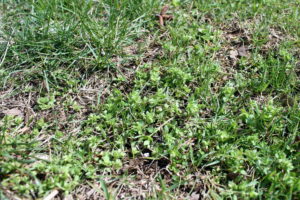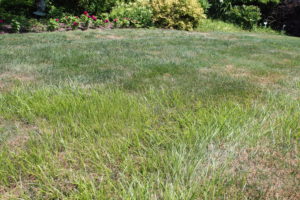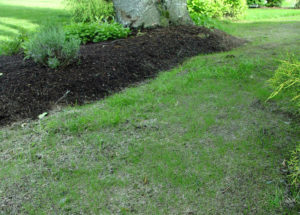Is a Decent, Chemical-Free Lawn Really Possible?
May 19th, 2020
I got an email from Cathy in Camp Hill wondering what to do about her 70-by-70-foot lawn that’s so overrun with weeds that there’s barely any grass left.
“I’m die-hard eco-friendly,” she says, “and I really don’t want to use anything toxic to the birds I feed or the insects they eat.”
She also says she has “dogs who like to eat soil for fun,” and she’s allergic to corn gluten meal, the main non-chemical way to prevent new weeds from germinating.
“I really don’t want to resort to Chemlawn and injure wildlife, but I plan to sell the house in six years and need to have the lawn under control by then,” she says.
With her current “lawn” consisting mostly of nutsedge, plantain, creeping charlie, crabgrass, smartweed, and a dozen other common lawn weeds, Cathy’s trying to figure out where to even begin.
“I’ve tried hand-pulling weeds and failed,” she says. “At this point, it’s 99 percent weeds and 1 percent grass and clover. So there’s no catching up by hand in an area of this size.”
She’s thinking about tarping the lawn in quadrants from June to August, hoping to smother the weeds. That would clear the way to rototill and plant grass seed in September.
“Is September enough time for the new lawn to get established before winter?” she asked. “Any way I can just seed over the killed plants when the tarp is removed without rototilling?”
This is a tough one… but one I thought I’d share because I think an increasing number of people are trying to reduce or avoid chemicals in pursuit of the long-esteemed green-carpet lawn.
The short answer is that it’s possible to grow a so-called “organic” lawn, but the reality is that 1.) it’s not going to be a weed-free carpet, and 2.) it might require some compromises to keep things from spiraling back out of control.
In Cathy’s case, the first job is to bring the yard back to ground zero. When weeds have won the battle to the tune of 99 percent to 1, it’s do-over time. The weeds have to go in order to make room for grass.
The usual rule of thumb is that when you have at least 50 percent grass vs. weeds, it’s possible to do a one-time spot-kill of the weeds with a broadleaf herbicide for lawns (i.e. one that kills broadleaf weeds but not grass) and then reseed the bare spots with grass.
End of March through April and between Labor Day and mid-October are the year’s two best windows for planting grass in our climate.
The drawback is that most broadleaf herbicides aren’t very good at killing grassy or grass-like weeds, such as nutsedge, nimblewill, crabgrass, quackgrass, and the like. For those, you’d have to use a second type of herbicide (sulfantrazone, halosulfuron-methyl, mesotrione, or even glyphosate, which kills most everything).
Of course, if you’re trying to go completely chemical-free, none of those are options.
That means you’re looking at either killing everything green with an organic/natural vegetable-killer, such as acetic acid or citrus or clove oils, or doing what Cathy is contemplating – smothering everything.
Even natural herbicides carry some off-target risks, so to me, the “safest” bets are tarps, sheets of black plastic, or any cloth barrier that denies light to the plants.
After six to eight weeks under a smothering barrier, just about everything will be dead. If you’ve ever let a kiddie pool sit on the lawn in the summer sun for even two or three days, you get the picture.
The reason to go weeks is to make sure the roots have died along with the top growth.
This is also the reason why it’s not as effective to just skip the smothering and go right to tilling. If you till living weeds, many of them will simply reroot, unless you meticulously remove them after the tiller has dislodged them.
Even beyond the rerooting problem, tilling doesn’t always kill all weeds. Sometimes the machine lops off the top growth above the crown, allowing new shoots to sprout from that growing point.
Other times, tillers dislodge a weed but bury it again nearby, where the weed sprouts anew in its slightly relocated home.
By killing all or most of the weeds via smothering, you greatly reduce the chance of rerooting.
Cathy’s game plan of smothering in summer and tilling/seeding at the beginning of September sounds like solid timing to me. New grass should germinate nicely then (assuming regular rain or watering) and have nearly three months of root growth before the ground usually freezes.

Raking is one way to incorporate grass seed into the soil surface. Use a garden rake if you haven’t already loosened the soil.
You’d have to at least loosen the soil with a rake to get good germination if you don’t rototill. Grass doesn’t sprout well when just tossed on top of hard ground.
Another option is renting a slit-seeder. This power tool has a drum that cuts shallow, vertical slits in the ground and then immediately deposits seed from a hopper behind the cutters.
Here’s where it starts to get challenging… if that wasn’t challenging enough.
As soon as you loosen the smothered soil and begin watering the new grass seed, you’re also going to cause weeds that you’ve stirred up in the soil to germinate. (Using that slit-seeder is an advantage here because you’re stirring up far fewer weed seeds than by tilling.)
Lawns that have had weed issues for years have lots of dormant weed seed that’s just itching to take advantage of the regular water and increased warmth and light near the surface. Think of it as a seed “bank” that’s had many healthy deposits.
Fewer weeds are going to germinate in fall, which is why I’d rate the Labor-Day-to-mid-October time frame as the absolute best grass-seed time.
But even if you get some great grass germination and growth in the first fall, the lawn is still going to be thin enough that a wave of other weeds will come up the following spring and summer.
In other words, that whole first year is going to be your biggest weed confrontation. That’s where one compromise could take place – you resort to a shot or two of weed-killers to knock back the early weeds and buy the grass more time to fill in.
Another option is to add more seed again in spring to help the grass fill in ASAP. Again, a slit-seeder would add that seed while doing as little disrupting as possible to the young grass that came up in fall.
Thick grass is at the heart of what will make or break any successful organic lawn-care effort.
To me, a good defense will fend off the good offense that weeds produce.
Everything you can do to grow and maintain a thick lawn will mean less room for any weeds to take hold, spread, and in Cathy’s case, re-create the same scenario she’s now facing.
Here’s a good long-term game plan:
Seeding thickly with a good-quality grass seed is the first step.
No. 2 is testing the soil so you can give grass every little advantage, such as optimal pH (around neutral 7.0 is ideal) and optimal nutrients (especially nitrogen).
Do-it-yourself soil test kits are available for $9-$10 through county Extension offices, many garden centers, and online at Penn State’s soil test laboratory.
Check out my past column for more details on how and where to acquire the best grass seed.
Switching to organic fertilizers won’t give you the steroidal growth of four-step chemical plans, but they cut down on the number of applications, feed over a longer time, and give suitable results.
Prong No. 3 is to keep the new lawn consistently damp to encourage thick growth as soon as possible. I’m not a proponent of watering mature lawns, but if you don’t keep a new lawn damp, those little roots die quickly, opening the door to weed growth.
Prong No. 4 is overseeding the lawn each fall with additional quality grass seed to maintain thickness, and ideally, top-dressing with about a quarter-inch of sifted compost. Compost adds both organic matter and nutrition.
Prong No. 5 is practicing a few good cultural things, such as cutting high (taller blades retain soil moisture and create slightly more shade to discourage weed-sprouting), letting the grass clips lie rather than bagging and removing them (they also add nutrition and organic matter as they break down), and keeping the mower blades sharp.
It helps if you cut your own grass since it’s possible for hired mowers to bring in weed seeds and disease spores from previous lawns if they’re not doing good between-job sanitation.
Finally, no matter how good you are at lawn culture, you’re going to get some weeds. That’s OK so long as the grass is dominant. But if you aren’t there to do a little “refereeing,” weeds can gradually start to out-compete turfgrass.
That’s likely what happened in Cathy’s case over the years.
If you can stay on top of the weeds early, it’s possible to control them by digging, pulling, and/or using one of the many long- and short-handled weeding tools available in garden centers and catalogs.
This is also the time for another possible compromise – using a liquid herbicide to spot-spray patches that are either too hard to yank or getting out of control. This technically disqualifies you as a strictly organic lawn-gardener, but then again, you’re limiting pesticides as much as possible.
All of that probably sounds more difficult than it really is. It’s certainly a lot easier to throw in the trowel and hire a lawn-care company to magically make you a green carpet. But with some rethinking of strategy and a bit of tolerance, it’s possible to have a fairly good lawn without poisoning anything.
Think of it this way. Grass somehow managed to grow long before there was Scott’s Four-Step or mesotrione.











